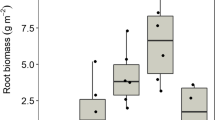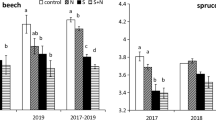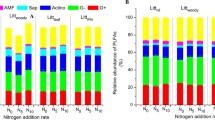Abstract
The aim of our study was to identify interactions between the decomposition of aboveground litter and rhizosphere activity. The experimental approach combined the placement of labelled litter (δ13C=−37.9‰) with forest girdling in a 35-year-old Norway spruce stand, resulting in four different treatment combinations: GL (girdled, litter), GNL (girdled, no litter), NGL (not girdled, litter), and NGNL (not girdled, no litter). Monthly sampling of soil CO2 efflux and δ13C of soil respired CO2 between May and October 2002 allowed the partitioning of the flux into that derived from the labelled litter, and that derived from native soil organic matter and roots. The effect of forest girdling on soil CO2 efflux was detectable from June (girdling took place in April), and resulted in GNL fluxes to be about 50% of NGNL fluxes by late August. The presence of litter resulted in significantly increased fluxes for the first 2 months of the experiment, with significantly greater litter derived fluxes from non-girdled plots and a significant interaction between girdling and litter treatments over the same period. For NGL collars, the additional efflux was found to originate only in part from litter decomposition, but also from the decay of native soil organic matter. In GL collars, this priming effect was not significant, indicating an active role of the rhizosphere in soil priming. The results therefore indicate mutual positive feedbacks between litter decomposition and rhizosphere activity. Soil biological analysis (microbial and fungal biomass) of the organic layers indicated greatest activity below NGL collars, and we suppose that this increase indicates the mechanism of mutual positive feedback between rhizosphere activity and litter decomposition. However, elimination of fresh C input from both above- and belowground (GNL) also resulted in greater fungal abundance than for the NGNL treatment, indicating likely changes in fungal community structure (i.e. a shift from symbiotic to saprotrophic species abundance).




Similar content being viewed by others
References
Berg B (2000) Litter decomposition and organic matter turnover in northern forest soils. For Ecol Manage 133:13–22
Berg B, Söderström B (1979) Fungal biomass and nitrogen in decomposing pine litter. Soil Biol Biochem 11:339–341
Bowden RD, Nadelhoffer KJ, Boone RD, Melillo JY, Garrison JB (1992) Contributions of aboveground litter, belowground litter, and root respiration to total soil respiration in a temperate mixed hardwood forest. Can J For Res 23:1402–1407
Chapela IH, Osher LJ, Horton TR, Henn MR (2001) Ectomycorrhizal fungi introduced with exotic pine plantations induce soil carbon depletion. Soil Biol Biochem 33:1733–1740
Cheng W (1996) Measurement of rhizosphere respiration and organic matter decomposition using natural 13C. Plant Soil 183:263–268
Dalenberg JW, Jager G (1989) Priming effect of some organic additions to 14C-labelled soil. Soil Biol Biochem 21:443–448
De Nobili M, Contin M, Mondini C, Brooks PC (2001) Soil microbial biomass is triggered into activity by trace amounts of substrate. Soil Biol Biochem 33:1163–1170
Dighton J, Thomas ED, Latter PM (1987) Interactions between tree roots, mycorrhizas, a saprotrophic fungus and the decomposition of organic substrates in a microcosm. Biol Fertil Soils 4:145–150
Dormaar JF (1990) Effect of active roots on the decomposition of soil organic materials. Biol Fertil Soils 10:121–126
Epron D, Farque L, Lucot É, Badot PM (1999) Soil CO2 efflux in a beech forest: the contribution of root respiration. Ann For Sci 56:289–295
Flanagan LB, Kubien DS, Ehleringer JR (1999) Spatial and temporal variation in the carbon and oxygen stable isotope ratio of respired CO2 in a boreal forest ecosystem. Tellus 51:367–384
Gadgil RL, Gadgil PD (1971) Mycorrhiza and litter decomposition. Nature 233:133
Gielen B, Ceulemans R (2001) The likely impact of rising atmospheric CO2 on natural and managed Populus: a literature review. Environ Pollut 115:335–358
Högberg MN, Högberg P (2002) Extramatrical ectomycorrhizal mycelium contributes one-third of microbial biomass and produces, together with associated roots, half the dissolved organic carbon in a forest soil, New Phytol 154:791–795
Högberg P, Ekblad A (1996) Substrate induced respiration measured in situ in a C3-plant ecosystem using additions of C4-sucrose. Soil Biol Biochem 28:1131–1138
Högberg P, Nordgren A, Buchmann N, Taylor AFS, Ekblad A, Högberg MN, Nyberg G, Ottosson M, Read AJ (2001) Large-scale forest girdling shows that current photosynthesis drives soil respiration. Nature 411:789–792
IPCC (2001) A Report of Working Group I of the Intergovernmental Panel on Climate Change. Climate change 2001: the scientific basis. Cambridge University Press, Cambridge, UK
Janssens IA, Sampson DA, Curiel-Yuste J, Carrara A, Ceulemans R (2002) The carbon cost of fine root turnover in a Scots pine forest. For Ecol Manage 168:231–240
Kuzyakov Y (2002) Review: Factors affecting rhizosphere priming effects. J Plant Nutr Soil Sci 165:382–396
Kuzyakov Y, Cheng W (2001) Photosynthesis controls of rhizosphere respiration and organic matter decomposition. Soil Biol Biochem 33:1915–1925
Liski J, Perrouchaud D, Karjalainen T (2002) Increasing carbon stocks in the forest soils of western Europe. For Ecol Manage 169:159–175
Martín-Olmedo P, Rees RM, Grace J (2002) The influence of plants grown under elevated CO2 and N fertilization on soil nitrogen dynamics. Global Change Biol 8:643–657
Mary B, Freseneau C, Morel JL, Mariotti A (1993) C and N cycling during decomposition of root mucilage, roots and glucose in soil. Soil Biol Biochem 25:1005–1014
Norby RJ, Wullschleger SD, Gunderson CA, Johnson DW, Ceulemans R (1999) Tree responses to rising CO2 in field experiments: implications for the future forest. Plant Cell Environ 22:683–714
Norby R, Cotrufo MF, Ineson P, O’Neill EG, Canadell JG (2001) Elevated CO2, litter chemistry, and decomposition: a synthesis. Oecologia 127:153–165
Olson FCW (1950) Quantitative estimates of filamentous algae. Trans Am Microsc Soc 69:272–279
Persson T, Karlsson PS, Seyferth U, Sjöberg RM, Rudebeck A (2000) Carbon mineralization in European forest soils. In: Schulze ED (ed) Carbon and nitrogen cycling in European forest ecosystems. Springer, Berlin Heidelberg New York, pp 257–275
Phillips DL, Gregg JW (2001) Uncertainties in source partitioning using stable isotopes. Oecologia 127:171–179
Rochette P, Flanagan LB, Gregorich EG (1999) Separating total soil respiration into plant and soil components using analyses of natural abundance of 13C. Soil Sci Soc Am J 63:1207–1213
Schweizer M, Fear J, Cadish G (1999) Isotopic (13C) Fractionation during plant residue decomposition and its implications for soil organic matter studies. Rapid Commun Mass Spectrom 13:1284–1290
Shen J, Bartha R (1996) Priming effect of substrate addition in soil-based biodegradation tests. Appl Environ Microbiol 62:1428–1430
Söderström B (1977) Vital staining of fungi in pure cultures and in soil with fluorescein diacetate. Soil Biol Biochem 9:59–63
Sparling GP, West AW (1988) Modifications to the fumigation-extraction technique to permit simultaneous extraction and estimation of soil microbial C and N. Comm Soil Sci Plant Anal 19:327–344
Sundman V, Sivela S (1978) A comment on the membrane filter technique for estimation of length of fungal hyphae in soil. Soil Biol Biochem 10:399–401
Van Vuuren MMI, Robinson D, Scrimgeour CM, Raven JA, Fitter AH (2000) Decomposition of 13C-labelled wheat root systems following growth at different CO2 concentrations. Soil Biol Biochem 32:403–413
Wallin G, Linder S, Lindroth A, Räntfors M, Flemberg S, Grelle A (2001) CO2 exchange of boreal Norway spruce at the shoot, tree and ecosystem level. Tree Physiol 21:969–976
Wang Y, Amundson R, Niu XF (2000) Seasonal and altitudinal variation in decomposition of soil organic matter inferred from radiocarbon measurements of soil CO2 flux. Global Biogeochem Cycles 14:199.211.
Werner RA, Brand WA (2001) Referencing strategies and techniques in stable isotope ratio analysis. Rapid Commun Mass Spectrom 15:501–519
Woodward FI (2002) Potential impacts of global elevated CO2 concentrations on plants. Curr Opin Plant Biol 5:207–211
Zak DR, Pregitzer KS, King JS, Holmes WE (2000) Elevated atmospheric CO2, fine roots and the response of soil microorganisms: a review and hypothesis. New Phytol 147:201–222
Zhu YG, Miller RM (2003) Carbon cycling by arbuscular mycorrhizal fungi in soil-plant systems. Trends Plant Sci 8:407–409
Acknowledgements
We would like to thank Ilaria del Galdo for the determination of microbial biomass in soil samples, Karin Sörgel and Michael Patecki for help with field measurements, Armin Jordan and Michael Rothe for CO2 mixing ratio and δ13C analyses of the gas samples, and Mauro Rubino for soil sample δ13C analysis. We also thank Tryggve Persson of the University of Uppsala (Sweden), for supplying data on soil C and N contents. This work was financially supported by the European Commission through the FORCAST project (EKV2-CT−1999–00035) and a Marie Curie Fellowship for J.-A.S. (HPMD-CT−2001–00088).
Author information
Authors and Affiliations
Corresponding author
Rights and permissions
About this article
Cite this article
Subke, JA., Hahn, V., Battipaglia, G. et al. Feedback interactions between needle litter decomposition and rhizosphere activity. Oecologia 139, 551–559 (2004). https://doi.org/10.1007/s00442-004-1540-4
Received:
Accepted:
Published:
Issue Date:
DOI: https://doi.org/10.1007/s00442-004-1540-4




